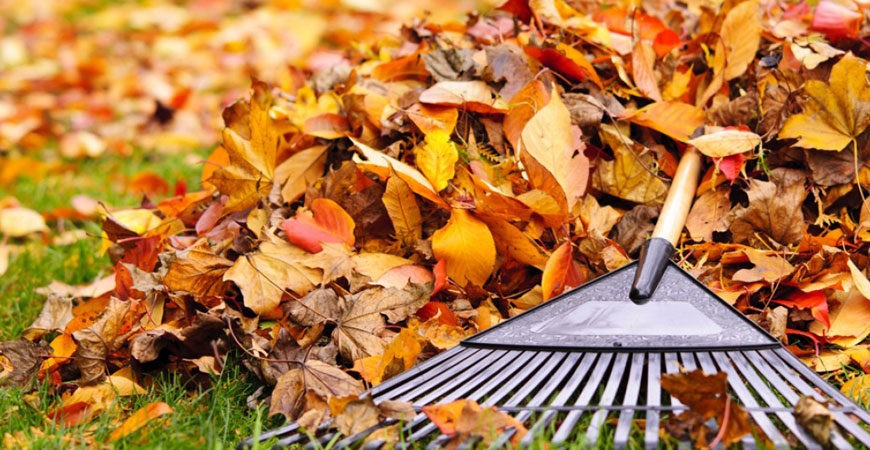Fall Clean-up and Winter Prep for Carmel, Indiana Lawns and Landscapes
With the change in seasons naturally come changes to your residential landscaping maintenance. In addition to final mowing, fall is the time to think about cleaning up your property, removing fallen leaves and preparing for the winter ahead.
These seven tasks will help protect your landscape during the winter months, allowing it to rest and be rejuvenated next spring. They will also help ensure that your property stays looking as it should throughout the year, especially during the holiday season.
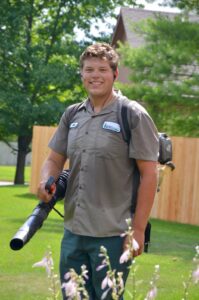 1. Leaf Removal
1. Leaf Removal
Most people love fall for the changing leaf colors. The beautiful reds, yellows and oranges provide quite a spectacular show before dropping from the trees and bushes. Then comes the clean-up.
We can adjust your maintenance contract according to your budget and the specific leaf-removal needs of your property. Your standard contract may only include one leaf removal. In this case the removal is delayed until all leaves have fallen, usually in November.
2. Aeration and Over-Seeding
Aerating and overseeding your turf is like giving your landscape a one-two punch of invigoration for a healthy start next spring. Think of it as first giving your lawns breathing room (aeration), and then preparing for new growth (over-seeding).
The process of aeration involves removing cores of grass and soil, allowing water, air and nutrients to reach plant roots directly. Aeration also reduces thatch – that accumulation of grass clippings and other organic matter that collects in a tangled mess on the surface around the grass stems. Additionally, aeration improves the lawn’s ability to collect and absorb rainfall. This helps reduce stormwater runoff and encourages organic material to penetrate deeper into the soil and maximize absorption of essential nutrients.
Over-seeding is a crucial aspect of keeping Indiana lawns at their best. Since mowing cuts off most naturally occurring seed heads during the growing season, fall is a good time to sow new seeds and fill in the thinning lawn.
3. Fertilization
 Once you’ve cleaned your lawn of debris, cut and aerated it, it’s necessary to fertilize it before the cold and snow arrive. Proper fertilization takes knowledge and skill just like all other steps in preparing your lawn to survive over winter healthily.
Once you’ve cleaned your lawn of debris, cut and aerated it, it’s necessary to fertilize it before the cold and snow arrive. Proper fertilization takes knowledge and skill just like all other steps in preparing your lawn to survive over winter healthily.
Most homeowners are somewhat familiar with fertilizer ratings. These ratings are N for nitrogen, P for phosphorus and K for potassium. High nitrogen fertilizers are great for the spring because they promote leafy vegetation growth. But that’s not what you want for your lawn in the fall. Phosphorus is the best material for supporting root and rhizome growth. Make sure to use fertilizer with a high P-rating.
Another word on fertilizers is that some are water soluble and others are slow-release granular types. Most professionals recommend granular fertilizer high in phosphorus for winter preparation. If in doubt, get professional advice from GreenLawn by Design — our experts know exactly what your lawn needs for the winter.
4. Irrigation Winterization
Avoid nasty water leaks—and the costs and complications that follow due to freezing pipes—and arrange for your irrigation system to be properly put to bed for the winter. A qualified irrigation technician will drain your system to remove all standing water from pipes and valves before the freezing temperatures set in, leaving it well-prepared to go back to work next spring. Backflows make tempting targets for thieves when they aren’t pressurized with water. Talk to your irrigation company about options to protect this valuable piece of equipment over the winter.
5. Mulch Your Trees and Plants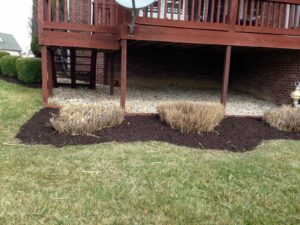
Nothing looks quite as good as a freshly mulched yard. Mulching in the autumn (as opposed to the spring) is a great way to make sure that your yard and garden stay healthy for the spring. Spreading 2-3 inches of fresh mulch (such as shredded leaves, bark, compost, sawdust, etc.) around the base of a tree or plant will enrich and insulate the soil, keep weeds down, protect roots from frost, and retain moisture.
6. Plant New Shrubs
Although many people think of planting new shrubs in the spring, autumn (September-December) can actually be better. “When adding trees and shrubs to your landscape, planting in the fall offers several benefits. It’s an ideal time for you, as all the hard gardening work of spring and the upkeep of summer will be winding down – plus it’s the best time for the tree. The combination of warm soil and cool air stimulates root growth to help your tree or shrub get established before the ground freezes. In the fall, trees and shrubs are either sold in containers or with root balls, where the root and soil is wrapped in burlap (often called “balled-and-burlapped”). Planting them is easy.”
You might also want to plant some colorful autumn flowers such as mums. And to protect your more delicate shrubs from rain, snow and ice, wrap them in burlap or if they’re small enough, place an empty bucket over them.
7. Trash Rem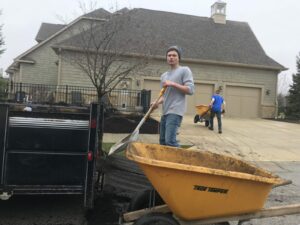 oval and Winter Weeding
oval and Winter Weeding
If these two tasks aren’t included in your residential landscaping contract, you should consider adding them. We can visit your property every other week throughout the winter to keep it looking its best. In the winter, trash is more visible after the leaves are gone.
And we can keep the winter weeds – yes, they do exist in Indiana – under control. All of this adds up to a clean, attractive property with nice curb appeal.
8. Disease Management and Prevention
After the leaves have fallen and been removed from the site, we can take a closer look at your plants to assess their overall health and check for signs of any potential disease or pest infestations.
One particular pest we deal with in Indiana on a regular basis is the spruce spider mite. In fact, nearly every spruce tree in Indiana has spider mites. They routinely cause damage every year, varying between location and tree species.
The best way to deal with pests and fungal disease is to break the cycle of contagion with Integrated Pest Management (IPM). Fall is the perfect time to halt the progression of any plant problems, protecting them for winter, and readying them to awaken and thrive next spring.
Thinking and Working One Season Ahead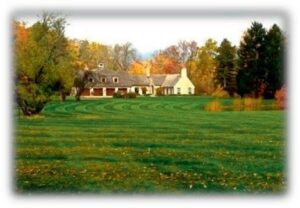
Let GreenLawn by Design help you with your fall residential landscaping tasks. We are happy to discuss the best ways you can plan and prepare in autumn to protect your valuable landscape through the winter – making sure it will be ready to spring back vigorously next year.
Call us today, in at 317-804-8088. Or, if you prefer, fill out our contact form and we’ll be in touch soon.

